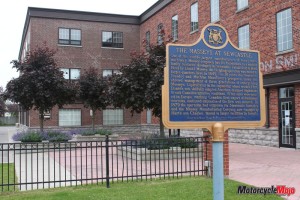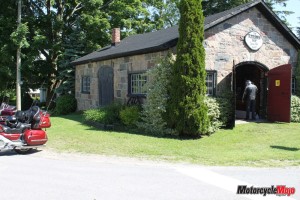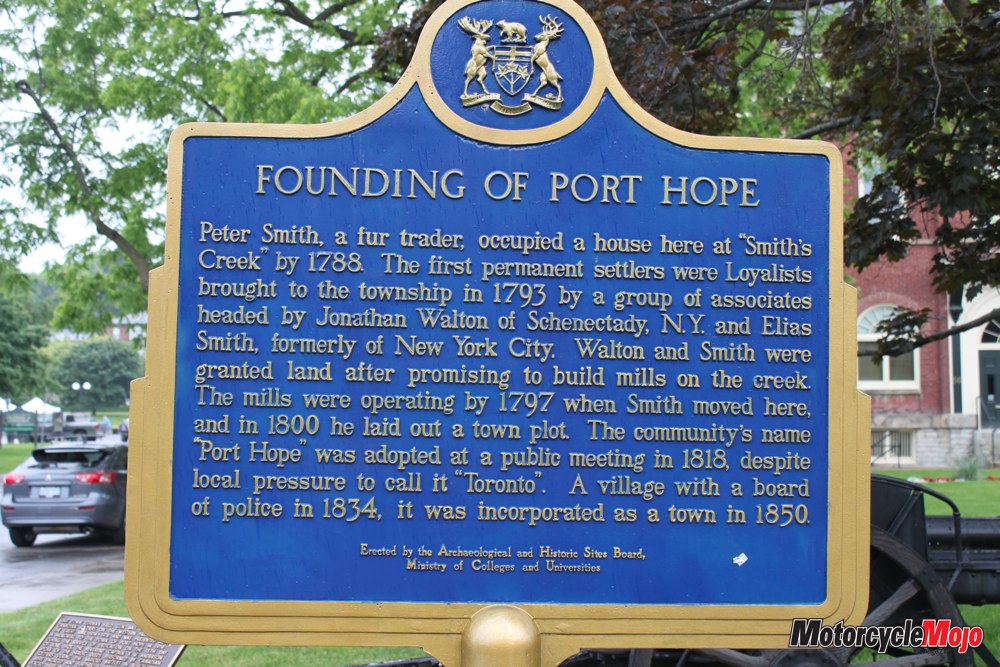Proof positive that an entertaining ride can be just outside your doorstep, and you might even learn something about local history
We travel to far-off destinations looking for great roads to ride, but sometimes the coolest rides are right on our doorsteps. A good ride is not just about spine-tingling, toe-dragging, metal-scraping corners. A good ride is often about spending valuable time with friends, enjoying beautiful weather and great food, and yes, discovering nice roads to ride on.
Many provinces etch their history on roadside plaques and monuments for the benefit of travellers who may take a few moments to read and silently thank those hardy people who came before us and paved our way. As a member of the Blue Knights Law Enforcement Motorcycle Club, I organize one ride each year, and this year I assembled a combination of doorstep roads and a smattering of history as displayed on some of Ontario’s historical blue plaques.
As we quietly wait for everyone to arrive at Port Perry’s waterfront, my wife Tina and I gaze out over what was once just a swamp, Lake Scugog. The romantic cruise boat, MV Woodman, solidly anchored against the dock in Scugog’s placid water, awaits another group of noisy visitors to float around the lake and Scugog Island.
In the park across the street is a blue plaque standing beside a statue of David Palmer. Palmer, the renowned father of chiropractic, was born in Pickering and raised in Port Perry. In 1856, his parents moved to the United States, and because of this, Americans lay claim to his discoveries. The fact remains that he was a Canadian and I, as well as many other motorcyclists, are thankful for his ingenuity.
 Six bikes and eleven people arrive as we head west on Queen Street to Old Simcoe Street, where the village of Borelia once stood. As Port Perry grew, Borelia was annexed and became part of the town that Peter Perry founded. Southward, winding past Sunday-morning garage sales, we arrive at the hamlet of Prince Albert. We head south about a mile, turn left, and stop at the home of the world’s greatest apple fritter, White Feather Farms. These fritters are monstrous – a whole meal by themselves.
Six bikes and eleven people arrive as we head west on Queen Street to Old Simcoe Street, where the village of Borelia once stood. As Port Perry grew, Borelia was annexed and became part of the town that Peter Perry founded. Southward, winding past Sunday-morning garage sales, we arrive at the hamlet of Prince Albert. We head south about a mile, turn left, and stop at the home of the world’s greatest apple fritter, White Feather Farms. These fritters are monstrous – a whole meal by themselves.
With a fritter in each saddlebag (so we won’t go in circles), we head east on Raglan Road. We pass by the little-known magnetic hill on our left at Purple Hill Conservation Area and roll on toward the Oshawa Townline Road. We are now on the Oak Ridges Moraine, and the pleasant scent of pine pitch reminds me that it’s springtime in Ontario.
At the hamlet of Burketon Station, a whistle-stop for the old Canadian Pacific Dayliner, we turn south on Old Scugog Road to Enniskillen. This is where the garage still stands that was once Robert McLaughlin’s Carriage Company. On Regional Road 57, we stop at another blue plaque erected near McLaughlin’s birthplace. McLaughlin started out building sleighs, then carriages, and eventually automobiles. His company evolved into General Motors of Canada. Fondly known as Colonel Sam, he was a noted philanthropist, and many institutions bear his name. The Parkwood Estate in Oshawa, an entire city block, was his home.
Touring slowly through the village of Tyrone, we pass the Vanstone Mill, a water-powered grist and sawmill built in 1846 that still derives its power from the Tyrone Millpond. The mill remains in operation, producing lumber and stone-ground flour. On a hot mid-August weekend in 1970, over 100,000 young people descended on nearby Mosport Park for Strawberry Fields, a Woodstock-like music festival. To beat the August heat, hundreds of young people went swimming naked in the Tyrone Millpond, much to the delight of the local old-timers, who lined the shores with their Kodak Instamatics.
 On the east end of Tyrone Village stands an authentic stone blacksmith shop. Built in 1854 by a Mr. Treneuth, it opened in 1857 and has been owned by the same family since 1896. The present owner’s grandfather ran this shop for 50 years. Although a fire partially destroyed the roof years ago, it has been restored, and the original forge and tools are still in the building, just as they were when Grandpa’s hammer could be heard clanging against the white-hot steel on the anvil decades ago. The home and shop are now for sale, as Gwen Woodcock, the granddaughter, needs to find a property with less maintenance. Gwen is kind enough to open the building and give us a tour.
On the east end of Tyrone Village stands an authentic stone blacksmith shop. Built in 1854 by a Mr. Treneuth, it opened in 1857 and has been owned by the same family since 1896. The present owner’s grandfather ran this shop for 50 years. Although a fire partially destroyed the roof years ago, it has been restored, and the original forge and tools are still in the building, just as they were when Grandpa’s hammer could be heard clanging against the white-hot steel on the anvil decades ago. The home and shop are now for sale, as Gwen Woodcock, the granddaughter, needs to find a property with less maintenance. Gwen is kind enough to open the building and give us a tour.
We leave eastbound, riding the ridges and paralleling fields filled with neat rows of corn that run for kilometres. Stone and root fence lines tell of yesteryears’ hard history, when this land was cleared from virgin forest. We leave Darlington Township and enter the former Clarke Township, and nestled in the next valley is the beautiful hamlet of Leskard on the shores of Wilmot Creek. About a kilometre north of here, in the gravel hills by the Canadian Tire Motorsport Park (formerly Mosport Park), springs bubble out of the ground, the humble beginnings of Wilmot Creek. Springtime brings mammoth rainbow trout and salmon 12 miles north from Lake Ontario; when they can go no farther, they lay their eggs.
On Leskard Road, we trundle along, passing the first log home that I built, back in the 80s. How I wish I’d kept it now. At Concession Road 7, we climb the hills where we get a wonderful view southward and head east to Hwy 35/115, and then south to Hwy 2. We stop beside the bridge over Wilmot Creek. We are about a mile from Lake Ontario, and history tells us that in the early 1800s a man could spear a thousand salmon in this creek in a single day. The blue plaque tells the story of the visionary Samuel Wilmot, the son of S. S. Wilmot, who surveyed Reach Township in 1809 when it was just wilderness and wild animals. With fish stocks dwindling, Wilmot began artificially hatching fish eggs as a means of saving the Lake Ontario salmon, and in 1865, he built a small hatchery on his farm just north of Hwy 2. Wilmot established 15 hatcheries across Canada, and his designs were widely copied in North America and Europe. Just up the road in Newcastle is another blue plaque that tells the story of the family that made the town famous, the Masseys. At the corner of King Avenue and Beaver Street sits the restored and renovated old Massey Factory.
Daniel Massey arrived in Bond Head on the shores of Lake Ontario before Newcastle existed, and went into business with a blacksmith. Within six months, he bought out his partner and began making mill parts and innovative farm implements. Eventually he moved his business north to Newcastle, a newly created village on the Danforth Road. Daniel’s son, Hart, inherited the business, and then his son Chester succeeded him. The business grew and sales increased dramatically. It became Massey-Harris-Ferguson, and then Massey Ferguson, as we know it today. Hart Massey had two very famous sons: Vincent, who became Canada’s 18th Governor General, and Raymond, who had a brilliant stage and Hollywood acting career. Hart was a philanthropist, and one of his donations was the beautiful Newcastle Town Hall, still standing proudly today.
Hosting everything from weddings to bowling in its downstairs bowling alley, it also houses the Newcastle Historical Museum. Just up and across the street, a blue plaque honours another famous Newcastle son, Joseph E. Atkinson, who became the editor and majority stakeholder of the Toronto Daily Star. Mill Street takes us south to Lake Ontario, where we follow Lakeshore Road east as it hugs the Lake Ontario shoreline through Port Granby, Wesleyville, Port Britain, and on to Port Hope. As we downshift, slowing on Port Hope’s steep Walton Street, we turn right on John Street to the Carlisle Inn & Bistro. Built in 1857, it was originally the Bank of Upper Canada, then a medical practice, and then the Port Hope City Dairy. David and Jeanne Henderson, the present owners, purchased the property in 1986, and it evolved over the years into the Carlyle Inn & Bistro.
After a great lunch on the patio, we go down the hill to the Port Hope Town Hall for another informational gem. Port Hope was originally going to be called Toronto, but at a public meeting in 1818, it was decided that Port Hope was a more popular name amongst the voters. Around the corner and up the hill on King Street, we find the beautiful St. Marks Anglican Church, where Queen Elizabeth and Prince Philip worshiped when they visited Port Hope in 1959. The Right Honourable Vincent Massey, Governor General of Canada, accompanied them.
A straight run across Hwy 2 takes us into Cobourg and its beautiful waterfront, where we find the plaques describing the founding of Cobourg and the Cobourg and Peterborough Railway. From here the ride is more fun, as we get into the pastoral, emerald hills of Northumberland and ride east to Grafton. North on County Road 22, we pass Ste. Anne’s hedonistic spa, built in 1858. Eddystone Road, nestled in the hills enshrouded in spring’s fresh coat of greenery, curves gently as we enter the tiny hamlet of Eddystone. On our left, the Eddystone Baptist Church, built in 1857, proudly stands against a backdrop of nature.
It is truly a miracle that this wooden edifice still stands after so many years. We wind our way through the hilly terrain and sweeping high-speed curves to Castleton, on to Morganston and into Warkworth, past the home of Warkworth Cheese. In the park at the corner of Mill Street and Old Hastings Road stands a blue plaque honouring J. D. Kelly, a renowned Canadian artist who painted many historical scenes of great moments in Canadian history We take a grand and picturesque ride all the way into Campbellford and the Trent River. In 1831, after the Napoleonic War, two Scottish-born brothers, Lieutenant Colonel Robert Campbell and Major David Campbell, were granted 2200 acres of land in Seymour Township.
A settlement was developed at the calmest and shallowest stretch of the river, which became known as Campbell’s Ford. We find the blue plaque in a little parkette just north of Campbellford’s arched bridge, and we take a few minutes to relax at the end of our ride. Ontario’s blue plaques are definitely a great way to map a ride, and who knows what history you might uncover. To find locations of Ontario’s historical blue plaques, go to ontarioplaques.com.






















































